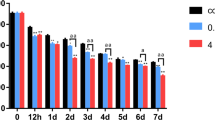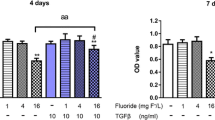Abstract
Fluoride accumulates and is toxic to bones. Clinical bone lesions occur in a phased manner, being less severe early in the natural course of skeletal fluorosis. Previous research rarely focused on osteocyte, osteoclast, and osteoblast at the same time, although these three types of cells are involved in the process of fluorosis. In this study, commitment of bone cells was performed according to their respective characteristics. Osteocyte-like cells were verified by protein expression of sclerostin (SOST) in IDG-SW3 cell culture with mineral medium. Positive tartrate-resistant acid phosphatase (TRACP) staining, characteristic of osteoclasts, is observed in RAW264.7 cells after administration of RANKL. We successfully purified a high percentage (94%) of bone mesenchymal stem cells (BMSCs) co-expressing CD34 and CD44. Parallel studies were performed to observe cell viability and apoptosis rates in osteocyte, osteoclast, and osteoblast like cells by using MTT and Annexin V FITC assays. Our results demonstrated that osteocytes have a strong tolerance to high fluoride concentrations, while osteoclasts are more sensitive to changes of fluoride dose. The range of anabolic action of fluoride concentration on osteoblast was narrow. Notably, fluoride exposure aggravated apoptosis of osteocyte and osteoclast induced by administration of PTH and TGF-β, respectively. In short, three types of bone cells display disparate responses to fluoride exposure and to PTH- and TGF-β-induced apoptosis.





Similar content being viewed by others
References
Brothwell D, Limeback H (2003) Breastfeeding is protective against dental fluorosis in a nonfluoridated rural area of Ontario, Canada. J Hum Lact 19:386–390
Hellwig E, Lennon AM (2004) Systemic versus topical fluoride. Caries Res 38:258–262
Bhawal UK, Lee HJ, Arikawa K, Shimosaka M, Suzuki M, Toyama T, Sato T, Kawamata R, Taguchi C, Hamada N, Nasu I, Arakawa H, Shibutani K (2015) Micromolar sodium fluoride mediates anti-osteoclastogenesis in Porphyromonas gingivalis-induced alveolar bone loss. Int J Oral Sci 7(4):242–249
Fina BL, Lombarte M, Rigalli JP, Rigalli A (2014) Fluoride increases superoxide production and impairs the respiratory chain in ROS 17/2.8 osteoblastic cells. PLoS One 9(6):e100768
Woo SM, Rosser J, Dusevich V, Kalajzic I, Bonewald LF (2011) Cell line IDG-SW3 replicates osteoblast-to-late-osteocyte differentiation in vitro and accelerates bone formation in vivo. J Bone Miner Res 26(11):2634–2646
Cuetara BLV, Crotti TN, O'Donoghue AJ et al (2006) Cloning and characterization of osteoclast precursors from the RAW264.7 cell line. In Vitro Cell Dev Biol Anim 42(7):182–188
Nadri S, Soleimani M (2007) Isolation murine mesenchymal stem cells by positive selection. Vitro Cell Dev Biol Anim 43(8–9):276–282
Bonewald LF, Johnson ML (2008) Osteocytes, mechanosensing and Wnt signaling. Bone 42(4):606–615
Xiong J, Onal M, Jilka RL, Weinstein RS, Manolagas SC, O'Brien CA (2011) Matrix-embedded cells control osteoclast formation. Nat Med 17:1235–1241
Lundy MW, Stauffer M, Wergedal JE, Baylink DJ, Featherstone JDB, Hodgson SF, Riggs BL (1995) Histomophometric analysis of iliac crest bone biopsies in placebo-treated versus fluoride-treated subjects. Osteoporosis Int 5:115–129
Chachra D, Turner CH, Dunipace AJ, Grynpas MD (1999) The effect of fluoride treatment on bone mineral in rabbits. Calcif Tissue Int 64(4):345–351
Mousny M, Omelon S, Wise L, Everett ET, Dumitriu M, Holmyard DP, Banse X, Devogelaer JP, Grynpas MD (2008) Fluoride effects on bone formation and mineralization are influenced by genetics. Bone 43(6):1067–1074
Matsuda SS, Silva TL, Buzalaf MA, Rodrigues AC, de Oliveira RC (2014) Differential effects of fluoride during osteoblasts mineralization in C57BL/6J and C3H/HeJ inbred strains of mice. Biol Trace Elem Res 161(1):123–129
Everett ET (2011) Fluoride's effects on the formation of teeth and bones, and the influence of genetics. J Dent Res 90(5):552–560
Yu H, Jiang N, Yu X, Zhao Z, Zhang X, Xu H (2018) The role of TGF-β receptor 1-smad3 signaling in regulating the osteoclastic mode affected by fluoride. Toxicology 393:73–82
Kaminsky LS, Mahoney MC, Leach J (1990) Fluoride: benefits and risks of exposure. Crit Rev Oral Biol Med 1:261–281
Koide M, Kobayashi Y (2018) Regulatory mechanisms of sclerostin expression during bone remodeling. J Bone Miner Metab. https://doi.org/10.1007/s00774-018-0971-7
Fulzele K, Dedic C, Lai F, Bouxsein M, Lotinun S, Baron R, Divieti Pajevic P (2018) Loss of Gsα in osteocytes leads to osteopenia due to sclerostin induced suppression of osteoblast activity. Bone 117:138–148
Hayashi M, Nakashima T, Yoshimura N et al (2019) Autoregulation of osteocyte Sema3A orchestrates estrogen action and counteracts bone aging. Cell Metab S1550-4131(18):30758–30757
Bellido T, Saini V, Pajevic PD (2013) Effects of PTH on osteocyte function. Bone 54(2):250–257
Houde N, Chamoux E, Bisson M, Roux S (2009) Transforming growth factor-beta1 (TGF-beta1) induces human osteoclast apoptosis by up-regulating Bim. J Biol Chem 284(35):23397–23404
Acknowledgements
This study was supported by the National Natural Science Foundation of China (grant number 81673111, Project “Study on role of osteocyte and PTH/TGF-beta signaling pathway in the mechanism of bone turnover occurred in skeletal fluorosis”), the Natural Science Foundation of Jilin Province of China (20180101151JC).
Funding
This study was funded by Project [Study on role of osteocyte and PTH/TGF-beta signaling pathway in the mechanism of bone turnover occurred in skeletal fluorosis] supported by National Natural Science Foundation of China (grant number 81673111) and by the Natural Science Foundation of Jilin Province of China (20180101151JC).
Author information
Authors and Affiliations
Corresponding author
Ethics declarations
Conflict of Interest
The authors declare that they have no conflict of interest.
Additional information
Publisher’s Note
Springer Nature remains neutral with regard to jurisdictional claims in published maps and institutional affiliations.
Rights and permissions
About this article
Cite this article
Jiang, N., Guo, F., Sun, B. et al. Different Effects of Fluoride Exposure on the Three Major Bone Cell Types. Biol Trace Elem Res 193, 226–233 (2020). https://doi.org/10.1007/s12011-019-01684-9
Received:
Accepted:
Published:
Issue Date:
DOI: https://doi.org/10.1007/s12011-019-01684-9




